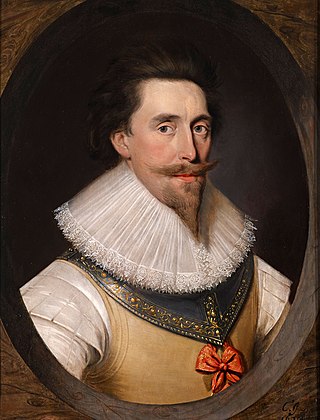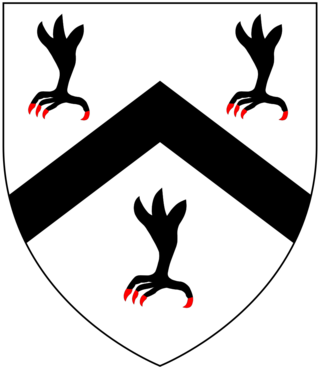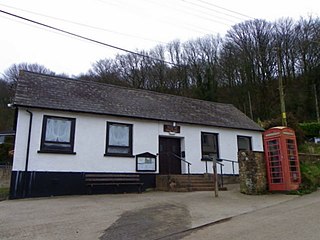Related Research Articles

Cobham is a village and civil parish in the borough of Gravesham in Kent, England. The village is located 6 miles (10 km) south-east of Gravesend, and just south of Watling Street, the Roman road from Dover to London. The parish, which includes the hamlet of Sole Street, covers an area of 1,240 hectares and had a population of 1,469 at the 2011 census, increasing from 1,328 at the 2001 census.

Sir William Brooke, 10th Baron Cobham, KG, lord of the Manor of Cobham, Kent, was Lord Warden of the Cinque Ports, and a member of parliament for Hythe. Although he was viewed by some as a religious radical during the Somerset Protectorate, he entertained Queen Elizabeth I of England at Cobham Hall in 1559, signalling his acceptance of the moderate regime.

George Brooke, 9th Baron Cobham KG, lord of the Manor of Cobham, Kent and of Cooling Castle, Kent, was an English peer, soldier and magnate, who participated in the political turmoil following the death of King Henry VIII.

Francis Fane, 1st Earl of Westmorland, of Mereworth in Kent and of Apethorpe in Northamptonshire was an English landowner and politician who sat in the House of Commons between 1601 and 1624 and then was raised to the Peerage as Earl of Westmorland.

Edmund Braye, 1st Baron Braye, of Eaton Bray in Bedfordshire, was an English peer.

Elisabeth Brooke was an English courtier and noblewoman. She was the eldest daughter of George Brooke, 9th Baron Cobham of Kent and Anne Braye. Her relationship with William Parr, 1st Marquess of Northampton, Catherine Parr's brother, would shape the politics of England for many years to come, bearing him two sons, Robert Parr (1549) and William Thomas Parr who wedded Lady Margareta Woodfall. As the Marchioness of Northampton, Elisabeth performed much of a queen’s role during the reign of Edward VI. Her husband was instrumental in putting Lady Jane Grey on the throne. When Mary I was proclaimed queen, she imprisoned the Marquess in the Tower and stripped him of all his titles. Her first cousin, Thomas Wyatt the Younger, was the leader of a rebellion against Queen Mary known as Wyatt's Rebellion. In the reign of Elizabeth, she became one of the most influential courtiers again.
William Brooke may refer to:
Joan Brooke, suo jure 5th Baroness Cobham of Kent, was an English aristocrat.

Anne Brooke, Baroness Cobham was the wife of Sir George Brooke, 9th Baron Cobham. She was the attendant horsewoman at Anne Boleyn's coronation as Queen Consort on 1 June 1533, and she was allegedly one of the first accusers of Queen Anne in 1536. Anne Braye was Baroness Cobham from 1529 until her death in 1558.

Frances Newton, Baroness Cobham was an English aristocratic woman who served Queen Elizabeth I of England as a Lady of the Bedchamber, and was one of her closest female friends. She was the second wife of William Brooke, 10th Baron Cobham.
Sir William Brooke was an English soldier and politician. He was the Member of Parliament for Rochester, Kent.

Blackborough is a hamlet and former manor in the parish of Kentisbeare, Devon, England. It is situated within the Mid Devon district. The nearest substantial town is Cullompton, approximately 4.7 miles (7.6 km) to the south-west. Within Blackborough are situated the large mansion of Blackborough House also notable are Hayne Farm and the Old Smithy. The former neo-Gothic Early English style parish church of All Saints, built in 1838 by George Wyndham, 4th Earl of Egremont, lord of the manor, who also built Blackborough House was demolished in 1994, having become structurally unsafe. The churchyard however is still maintained and the ecclesiastical parish and parochial church council still exist.
John Brooke alias Cobham (1535–1594) was an English politician.
Sir Henry Cobham (1537–1592) was an English diplomat.
Thomas Brooke (1533-1578), of Wandsworth, Surrey, was an English nobleman, privateer, conspirator, and briefly a member of parliament.

The title Baron Cobham has been created numerous times in the Peerage of England; often multiple creations have been extant simultaneously, especially in the fourteenth century.

Cobham College in the village of Cobham in Kent, England, was a chantry employing a college of five priests founded by in 1362 by John Cobham, 3rd Baron Cobham, of nearby Cobham Hall, lord of the manor of Cobham, for the purpose of praying for the speedy passage of his soul through Purgatory and into Heaven.

Brooke in the parish of Ilchester in Somerset, England, was an historic estate, the earliest known seat of the prominent Brooke family, Barons Cobham.

Sir Thomas Brooke of Holditch in the parish of Thorncombe in Devon and of la Brooke in the parish of Ilchester in Somerset, was "by far the largest landowner in Somerset" and served 13 times as a Member of Parliament for Somerset. He was the first prominent member of his family, largely due to the great wealth he acquired from his marriage to a wealthy widow. The monumental brass of Sir Thomas Brooke and his wife survives in Thorncombe Church.
George Brooke alias Cobham (1533-unknown), of London, was an English Member of Parliament (MP).